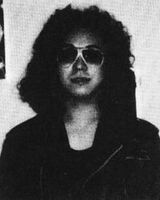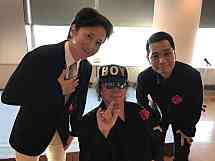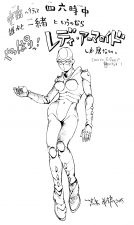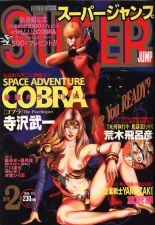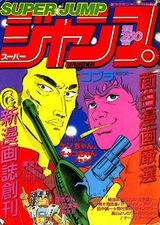Buichi Terasawa
Buichi Terasawa (寺沢 武一, Terasawa Buichi) is a Japanese manga artist. He is best-known for his manga series Goku Midnight Eye, Cobra, and Karasu Tengu Kabuto.
Terasawa supported Araki early in his career and is most notable for being the namesake for Cool Shock B.T. and the inspiration for Hol Horse in Stardust Crusaders.
History
Work with Araki
Terasawa's connection with Hirohiko Araki dates back to the 80s when he read the manuscript for Araki's debut manga, Poker Under Arms, submitted to the Tezuka Awards. Terasawa noted that while Araki wasn't very skilled at drawing, he still had a talent for storytelling. He also noted that the elaborate methods Araki used for composing stories would be better suited for writing novels and screenplays than for drawing manga.[1] Terasawa would go on to support Araki saying, "I encouraged him because he could tell stories better than he could draw them." The initials "B.T." in Araki's first series, Cool Shock B.T., are also a reference to Terasawa's name.[2][3][4]
In 1985, Terasawa appeared at the end of the first volume of Araki's second series, Baoh the Visitor. He said the sci-fi elements in the series were very reminiscent of the ones that appear in his own.[1] In 2014, Araki said that the idea for Hol Horse might've been inspired by the titular main character of Terasawa's manga, Cobra. A gun-slinging outlaw who always smokes and has the power to fire projectiles without having a line-of-sight.[5] In 2015, Araki contributed an illustration of Cobra's partner, Lady Armaroid, for the book Cobra Great Dissection. The reason Araki drew her was because "If you visit space and need a companion at your side, the Lady Armoroid is the only one for you! (Erotic, gorgeous and dependable)."[6]
Works
- "Black Jack" (ブラック・ジャック) (1973-1983) (Assistant to Osamu Tezuka)
- "Sigma 45" (シグマ45) (1976-1977)
- "Cobra" (コブラ) (1977) (One-shot)
- "Cobra" (コブラ) (1978-1984)
- "BLACK KNIGHT BAT" (BLACK KNIGHT バット) (1985)
- "Karasu Tengu Kabuto" (鴉天狗カブト) (1987-1988)
- "Goku Midnight Eye" (MIDNIGHT EYE ゴクウ) (1987-1989)
- "Takeru" (武 TAKERU) (1992-1993)
- "Gun Dragon Σ" (GUNDRAGON Σ) (1999)
- "Gun Dragon II" (GUNDRAGON II) (2004)
Interviews
Commentary
Most of these subtle attentions to detail go unnoticed by the reader, like the sci-fi themes scattered throughout the story and the deliberate awe created by the protagonist. Nonetheless, this is precisely where a science fiction writer gets to put their skills to the test, trying to visualize what we can only see in our wildest dreams. I mentioned earlier that our styles were similar. That's because I felt that his approach to drawing manga was very close to mine. There are very few artists who can make sci-fi manga entertaining without compromising the overall quality of their work, and Araki is one of them. Given his current style, I think he'll continue to grow as a manga artist in the future.
It's important to recognize that science fiction manga isn't the same as novels or films. At first, this seems obvious, but I think it's something necessary to keep in mind. I hope the both of us will continue drawing science fiction manga until we truly understand what it means.彼は何よりもまず、ストーリー展開を何度も緻密に練りあげてから構成していく。人間関係はもちろん、それを取り巻く状況、センス・オブ・ワンダーをどこに置くかなど、すべてを完壁に把握した上でなければ語り出さないタイプだ。とはいっても、これは小説や脚本を書くのと同じ手法であって、連載マンガ家としては非常に不利な一面を持っている。
みを求めるあまり、画面の中にちりばめられたSF的感性や主人公の中にある計算されたワンダーに、すべては大気のように気づかれず読み落とされる場合が多い。
しかし、SF作家はそこにこそ自らの資質をつぎ込み、自分の白中夢を映像化しようとこころみる。
先に、彼と僕は同じにおいがしたといったが、それは彼の求める作品の方向が、僕のそれと非常に近しいと感じたからだ。
SF漫画において、作品の質を低下させずになおかつ、エンターテイメントであろうとする作家は数少ない。彼はもちろんその中のひとりであり、今後、今のにおいを持ったまま成熟してゆくと思う。
SF漫画にSF小説でもSF映画でもない。あたりまえのことのように思えるが、SF漫画を描く上ではこの認識が最も重要であり、難しいものだと思う。
お互いそれを意識し、SF漫画というものが何者であるかを知るまで描き続けていきたいものだ。Gallery
References
| This page uses Creative Commons Licensed content from Wikipedia (view authors). |
